The Ford Transit Connect isn’t technically a minivan, but in several ways – most notably its size – it’s more deserving of the name than the not-very-mini-vans being sold today.
Models like the Toyota Sienna, Honda Odyssey and Chrysler Pacifica. They are many things – many of them good – but “mini” isn’t one of them. They are more like two-thirds-scale RVs.
Price-wise, too.
The freight for a loaded Sienna, Odyssey or Pacifica can land south of $45,000.
If you’d like something that’s a lot less expensive – and much more mini – you might want to have a look at the Transit.
No matter what Ford is technically calling it.
The Transit Connect is a modern take on the original minivan idea – and a counterpoint to the modern not-so-mini-van idea.
Like the ’80s-era vans so many of us grew up with, it’s not much larger than a car but inside, it’s got room for as many as seven people in three rows of seats. It also has as much as 128.6 cubic feet of cargo capacity, too.
And unlike today’s goliath-sized minivans, it’s not expensive.
 Base price is $23,120 for a regular wheelbase cargo van with two person (driver and passenger) seating, dual manual sliding side doors and a pair of outward-opening rear doors.
Base price is $23,120 for a regular wheelbase cargo van with two person (driver and passenger) seating, dual manual sliding side doors and a pair of outward-opening rear doors.
A top-of-the-line Titanium trim dressed with heated leather seats (and three rows of seats), power folding exterior mirrors, automatic climate control and a 6.5 inch LCD touchscreen stickers for $30,435.
You can opt for a minivan-style one-piece rear liftgate with this one, too.
One of the Transit’s rivals is the Nissan NV200 – which is also sold under the Chevy label as the City Express. It costs less to start ($20,870) but it is much more appliance-like. It only comes with two seats (driver and shotgun) with nothing behind them but a big empty box.
It’s a good choice for a contractor or small business owner, though.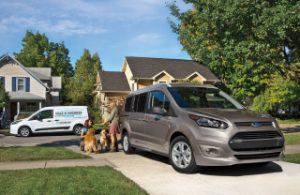
The Dodge Ram ProMaster City is another rival. It has the most cargo capacity of the three (as much as 131.7 cubic feet) and uniquely offers a “high roof” body and can carry 1,900 lbs. of cargo (much more than the Nissan NV and more than the TransitConnect) but only offers two rows of seats and five-passenger capacity – and doesn’t offer higher-end amenities like the Ford’s available panorama glass sunroof.
Base price for the ProMaster City is $23,445 for the two-person/commercial-duty Cargo trim – topping out at $26,070 for a five-person SLT Wagon.
All Transit Connect trims get a new front clip and cruise control is now part of the standard equipment package.
The available LCD touchscreen has been updated with Ford’s Sync 3 software/layout and you can get the top-of-the-line Titanium trim in short wheelbase/five-passenger/two-row form.
Previously, you had to buy the longer wheelbase/three row layout if you wanted the Titanium’s high-line features and amenities.
More versatile than its rivals. Short and long wheelbase versions; two, five or seven passenger capacity.
Take your pick of rear door styles.
Not as spartan-feeling as its rivals, even in base Cargo trim.
Can tow 2,000 lbs. – which is 2,000 lbs. more than the Nissan NV200 can tow.
No turbo. So no turbo to fail post-warranty.
Huge windshield frontal area gives outstanding view of the road ahead.
Low step-in/floor height makes this van exceptionally easy to get into and to load/unload.
Ram ProMaster can carry – and pull – more stuff.
If you don’t order the extra-cost side glass, the view to the side is not outstanding.
One-piece rear liftgate limited to most-expensive Titanium trim.
No diesel for us.
The Transit’s standard engine is a 2.5 liter, 169 hp four paired to a six-speed automatic.
This is a combo that’s becoming hard to find in vehicles generally. Simple – no turbo – and probably bullet-proof for many years and miles to come.
That also goes for the transmission – which isn’t a nine or ten speed transmission.
Or a CVT.
The Ford’s engine is much stronger than the Nissan NV200’s 2.0 liter four (131 hp) which barely has enough gumption to pull the van along and forget about pulling a trailer. The under-engined Nissan is rated to pull . . . nothing. “Trailer towing is not advised,” it says in the owner’s manual.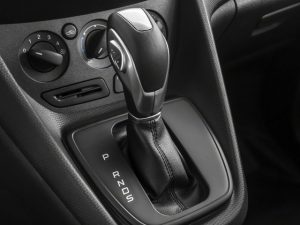
The Ford, on the other hand, can pull a 2,000 lb. trailer and carry 1,620 lbs. of whatever inside. Like a load of logs, for instance. Or a couple of motorcycles.
The Ram ProMaster City is a closer shave, cargo-wise.
It has the same 2,000 lb. maximum trailer rating as the Ford – but you can pile 1,883 lbs. of logs or whatever inside the thing. About 200 pounds more than the Transit. The Ram’s mileage is best of the bunch, too: 21 city, 29 highway – vs. 19 city, 27 highway for the Ford.
It comes standard with a 178 hp 2.4 liter four – the strongest engine of the bunch – but it’s paired with a hyper-active (shifts up and down constantly) nine-speed automatic that is much more complicated than the Ford’s six-speed automatic and which will probably be less reliable as a result and without doubt cost more to repair/replace in the event that becomes necessary.
As OJ used to say, look out!
The Transit is front-wheel-drive, like its rivals. None offer all-wheel-drive optionally. Interestingly, neither do most of the current not-so-mini-vans, almost all of which once did.
AWD has become very popular . . .in crossovers.
Like the ‘80s-era minivans, none of these mini vans are particularly speedy.
They all take about 10 seconds to get to 60. But that is enough – if you are alert.
Other vehicles are potentially speedier, but that only matters if their drivers aren’t half asleep, texting or otherwise not actively driving.
Mostly, they slow-poke along, no matter what they’re packing under the hood. Which is good in a way because it makes up for the deficit of actual power in a vehicle like this.
Of the three, the Ford is the only one with a conventional six-speed automatic. The Nissan has a continuously variable (CVT) automatic and the Ram has the nine-speed automatic already discussed above (sourced from Fiat, which owns Chrysler, which owns Dodge and Ram).
The Transit’s transmission behaves conventionally. It shifts, the van goes. Nothing unconventional about it.
In the Nissan, you’ve got a shift-less CVT.
No gear changes because there are no gears to change. CVTs are basically variable speed transmissions that transition rather than shift from range to range, depending on how much the driver pushes down on the accelerator pedal. If the driver pushes down hard, the engine won’t do the usual thing of revving up – followed by the transmission shifting and engine revs decreasing with each upshift. Instead, the engine will rev – and keep revving. RPMs will climb to the upper regions and sometimes right up to near redline and remain there for as long as the driver keeps his foot in it.
Particularly if the engine is under-powered for the application – as in the NV200. There will be a lot of noise and other signs of mechanical struggling during acceleration.
Ironically (because CVTs are used in lieu of conventional automatics with fixed gears in order to boost fuel economy) the Nissan’s mileage and performance stats are still the worst of the three.
The Ram ProMaster’s nine-speed automatic, on the other hand, shifts too much.
It spends a lot of time hunting for the right gear – which is a hard gear to find sometimes, given how many of them there are. Going downhills, the vehicle sometimes feels like it’s jumping forward – which it is. The transmission is programmed to get into the highest possible gear as soon as possible – to reduce engine RPM, for maximum economy. But leap-frogging from 5th to 9th results in a weird forward-surging sensation, even though your foot’s off the accelerator.
As with the CVT, the Ram’s nine-speed box is there for maxiumum efficiency. And while it does deliver, it’s not much of a difference. Just 4 MPG in city driving and 1 MPG on the highway. In real-world driving, it’s a negligible difference vs. the Transit.
Which doesn’t surge forward on the downslopes.
Ride (and handling) wise, all three of these jitneys do their best work at lower-than-highway speeds. As speed increases, they put you more in tune with the sounds of the outside world, including wind and tire noise.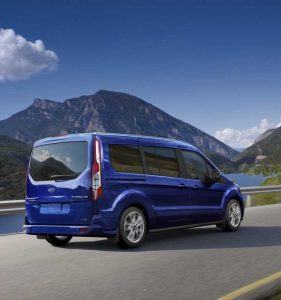
Wagon/passenger versions of the Transit are better in this respect – because they’re insulated. But the Transit is still noticeably noisier than not-so-mini-vans like the Sienna and Odyssey, which have become luxury buses more so than minivans.
On the other hand, the Transit – which shares its suspension/chassis underthings with the Escape crossover and C-Max wagon – actually handles not-badly. It has a pretty tight turning circle – 36.1 feet for the standard wheelbase version – and because it’s lower to the ground, so is the center of gravity – which makes it feel less top heavy in the curves.
The ride is a bit bouncy – but that’s true of all three.
Particulrly for the Nissan NV200, which is the most Kenmore-like of the bunch.
The Ram also leans more toward the utilitarian. It is taller (74 inches vs. 72.5 for the Ford) and while that’s helpful in terms of cargo space (and versatility; you can get taller objects inside) it is a liability in terms of road noise at highway speeds. The ProMaster is also more susceptible to being buffeted by crosswinds.
Like the Nissan NV, it also comes in just the one (long) wheelbase: 122.4 inches vs. either 120.6 (long wheelbase) or 104.8 inch (short) wheelbase for the Ford. The short-wheelbase Ford is much more close-quarters friendly and on the highway, it handles more like a car than a UPS truck.
One thing to know about all these rides is that without the extra-cost side glass, visibility to the side is awful. Making a left turn onto a busy road from a side street in the base Cargo version without side glass will make you wish you’d spent the extra few bucks for the side glass.
AT THE CURB
All of these things are a little weird looking.
Or, cute.
It depends on your point of view.
They are stubby and have snout-like noses. They’re also a type of vehicle still fairly unusual to see on American roads because of something called the “chicken tax,” which makes them more expensive to import.
Uncle at work – again.
The Transit and its main rivals all have the minivan virtues of very low step-in (and floor/loading) height, which makes them easier to get into and out of – and get cargo in and out of.
Ramps are not necessary.
But the biggest appeal, probably, of a vehicle like the Transit is that it is manageably sized.
In regular wheelbase form (104.8 inches) it is only 173.9 inches long. To get a sense of that, a Honda Civic sedan – which is a compact sized car – is 182.3 inches long. The “compact” Civic is 8.4 inches longer overall than the Transit. But its maximum cargo capacity is just 15.1 cubic feet vs. 103.9 cubic feet for the Transit.
And a compact sedan like the Civic seats only five – while the Transit can handle as many as seven.
On the other end of the scale, a standard-sized not-so-mini-van like the Dodge Caravan has more room for cargo – 143.8 cubic feet – but it is also almost two-and-a-half feet longer overall (202.8 inches vs. 173.9) and also has a much wider turning circle (39.1 feet vs. 36.1 feet).
Current not-so-mini-vans can be a lot to live with. And find parking space for.
Mini-vans like the Transit are much less of a handful.
This includes the long wheelbase version (120.6 inches) which is still only 189.7 inches long overall (only a few inches longer than the Civic) but offers 128.6 cubic feet of cargo capacity.
It’s nice that Ford offers you the option, too.
The Nissan NV200 comes only in short wheelbase (115.2 inches) form – but it’s still longer overall (186.3 inches) than the regular wheelbase Transit. It does have more capacity for cargo than the regular wheelbase Ford – 122.7 inches – but remember: It’s not available with seating for more than two and it can’t pull anything.
The Ram ProMaster, meanwhile, comes only in long wheelbase (122.4 inches) form and has the most cargo capacity 131.7 cubic feet and its taller roofline makes the space more usable, particularly for tradesmen, who might line the walls with tool racks and shelving. But despite its cargo-utility room advantages, it still seats a maximum of five and is less suitable for use as an actually mini-van.
Ford goes after that end of market much more aggressively, offering not just the three rows of seats but also amenities such as leather seats, climate control, a roof-length panorama sunroof, sound-deadening acoustic exterior glass, rain-sensing wipers and a 6.5 inch LCD touchscreen.
Dual sliding doors and four-wheel-disc brakes are standard. Nissan charges extra for the second slider and the NV200 comes standard with rear drum brakes. Forget the heated leather seats and climate control AC.
You’re lucky they offer manual AC.
And in addition to the minivan-style dual sliding side doors, the Ford also offers something the others do not: The option to go with a minivan-esque one-piece liftgate or a pair of sideways-opening doors.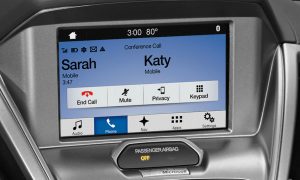
The new Sync3 interface – with its smartphone-like pinch/zoom controls and larger tap/swipe icons – is a big improvement over the prior MyFordTouch rig.
The available heated windshield (electric grid embedded in the glass) is another plus, if you have to deal with winter. Without this assist, all that glass would take a long time to defrost on a cold day.
There is very little not to like about this mini-van in everything except name.
One of the few nits I’ll pick is that you can’t get the one-piece rear liftgate in the lower trims.
It’s only available in the top-of-the-line Titanium.
THE REST
Shamefully, the 40 MPG-capable diesel engines that are available in the European-spec versions of all three of these vans are not available in the U.S. For example, the 1.5 liter Duratorque diesel that you can buy in the Transit in the UK and Western Europe. 
It doesn’t meet U.S emissions standards – so we can’t have it.
This doesn’t mean these diesels are “dirty.” No vehicle engine made in decades – whether gas or diesel-engined – is “dirty” in any meaningful sense. Only in the bureaucratic sense of not complying with the EPA’s hair-splitting Bins and Tiers – which define as “dirty” emissions which are fractionally higher than what was permissible last year or the year before.
Neither amounting to very much.
THE BOTTOM LINE
It’s a mini-van like they used to make them.
. . .
Got a question about cars – or anything else? Click on the “ask Eric” link and send ’em in!
If you like what you’ve found here, please consider supporting EPautos.
We depend on you to keep the wheels turning!
Our donate button is here.
If you prefer not to use PayPal, our mailing address is:
EPautos
721 Hummingbird Lane SE
Copper Hill, VA 24079
PS: EPautos stickers are free to those who send in $20 or more to support the site. Also, the eBook – free! – is available. Click here. Just enter you email in the box on the top of the main page and we’ll email you a copy instantly!




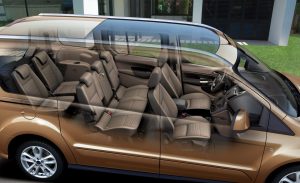














I’ve owned a short wheelbase 2014, which I bought used in 2015, now going on 7 years and 92K miles. I’ve averaged 27.3 MPG. Major service included new rotors and pads around 40K, and new struts around 85K. Full synthetic every 8K, and have followed the maintenance schedule to the letter. She still looks showroom new, the interior has held up well, the only ongoing issues are the headliner is loose around the sliding doors, and the airbag light is always on. We’ve taken long road trips, and use it regularly for moving furniture, landscaping material, loads of junk, and it has never let us down. If I ever replace it (no more SWB), I’d get the exact same one.
Hi Steve,
I dig these little jitneys, too! I used the last one I test drove to haul one of my bikes over to a friend’s shop. It was easier than getting the thing into the bed of my truck. I’ve seen videos of RV conversions, too. If I were 25 today, I could see myself living in one of these…
After reading this, I took the family to look at a used 2015 Transit Connect Titanium on a lot 5 miles from home. Black exterior, black/cream leather, backup sonar, navigation, USB interface, heated seats, 2/3/2 seats, roof crossbars, clean one-owner CarFax, less than 30k miles. All for less than $20k.
Unfortunately, they did not like it. One not at all. 😀 I really liked it, but I would not be the primary driver, so I got vetoed.
So glad to see the lack of turbo and complicated tranny! Eyeing one of these for the next car, but that will probably not be for years and years. The first-gen Highlander we got a few years back still hopefully has lots of life left, and can fit at least 1 more kid.
Hi Zach,
Me too!
I got two motorcycles in one of these things… I dig that!
I’ve had several friends who bought basic utility vans they then made into what it was they wanted.
The last was a couple who needed to get an ancient mother to a wedding in CA and take a sight seeing/camping vacation to many states between Tx and Ca.
They bought the largest vanDodge makes and put in the type of windows where they wanted, built benches, made custom everything including storage and a table with recliners for all. It was a luxury RV when they were finished made specifically for the 3 of them for that trip.
Removing recliners and adding bed space they later took grandkids on vacation.
And with little expense change it to other specific needs like going to the coast and having a full blown camper for their yearly birdwatching trip to the Tx coast.
It’s one of the best ideas for having what you want when you want it I’ve seen anyone do.
Hell, I remember when a second-hand VW Bus was the coolest DIY camper van that evry 17-21 year old would die to have. Affordable, economical, super-diversified, and prolific, found virtually everywhere in the country!
We had one for 9 years and used it for everything. Would have had it longer but my folks drove the ever-loving piss out of it, blowing the motor 3 times and putting well over 300K on the clock! Bought it new in 1970 for about 3-4K tops. I think he sold it for about 1.5K in 1979. I sure do miss it a lot sometimes.
Hi Graves!
Our Clover friend got a taste of his own medicine, it appears: http://bikemike.squarespace.com/weekly-journal/2017/8/25/why-not-say-yes.html
I Like the transfer Connect. Not just another CUV.
And considering all the designed-in utility, it’s not that bad looking.
You see a lot of them at dog shows, because despite their relatively small size, they can carry 3, 4…or even more dog crates (depending on the size of the dogs.)
Hi Mike,
Second all of that. I have carried two motorcycles in one – as well as a pretty large load of firewood!
Completely off topic, but has anybody seen this yet:
Mystery Surrounds Metal Towers Popping Up In Tunnels & Bridges
http://newyork.cbslocal.com/2017/09/27/mysterious-metal-towers/
These things are popping up in NYC along highways and bridges and nobody in government either has, or is willing to give to us Mundanes, an explanation of what they are, what they do, or why they cost over $100 million.
They are most certainly some kind of new, creepy, Big Brother horror, my guess is they may be V2V monitors/controllers of some sort.
Hat tip, AF… I’m gonna try to find something out..
More than welcome.
I’m searching the intertubes as well, if I find anything I’ll post it back to this thread.
They “host cameras, traffic monitoring and other equipment related to homeland security that would otherwise have been hosted by the former toll booth structures,” said MTA spokesman Shams Tarek at the time.
So says this article:
http://www.politico.com/states/new-york/city-hall/story/2017/09/25/mta-bridge-and-tunnel-towers-to-cost-100m-114695
Sort of puts that whole government for and by the people thing to rest now don’t it?
If this were legitimate protective technology without dual purpose it could be described without giving any secrets away. The secrets are in how it works not what it does. In fact such a description would work as a deterrent.
Since the people aren’t being told that means it must be at the very least a dual use technology that is monitoring people’s movements.
This is the city just north of me. Plate readers at every road into town.
http://nwigazette.com/2017/09/28/city-of-hammond-announces-completion-of-blue-net/
If you remember this is the same city that got caught on tape breaking out the window of a passenger (and dragging him out in front of his kid) on a traffic stop, and another time beating one of their own K9’s.
At least at the moment Indiana state law prohibits camera use for revenue generation. But I wouldn’t put it past this city with its past history, to try to slip that past the state. The same mayor did ask for permission to do revenue generation a few years ago (and was turned down). I am sure his is eying the money he could make from out of town motorists and will likely just turn them on and not ask this time around. Another nearby town operated a town court for years before someone noticed they had no right to do so.
Big brother is watching.
The interstate running through has been covered just about completely for a number of years already.
The thing about the Ford vs. the ProMaster and NV200 is you can option it so that you don’t feel like you’re driving an airport shuttle bus.
Hi Chip,
Yup!
The one I have to test drive time is loaded – Titanium with three rows of seats, all the options. It’s a damned nice family van and it costs easily $10k less than a loaded Sienna or Odyssey…
I am surprised I don’t see more families on budgets with the Transit. Maybe most don’t know its an option, since Ford doesn’t seem to promote them much as a passenger van. The only other affordable minivan left is the outgoing Dodge Caravan. Maybe more will find it when the Dodge is gone, since Chrysler seems to want out of the budget minivan biz.
Used to be there were two groups of minivan buyers. 30-40something couples with kids, buying the cheaper non-loaded ones. The other group 60’s and up looking for a good travel vehicle with all the options. I suppose the younger group buys more SUVs now that there are more options with those. Minivans are getting the oldster label on them since they are the only ones that can really afford them anymore. $40k+ on a vehicle with some of the worst depreciation in the industry doesn’t help either.